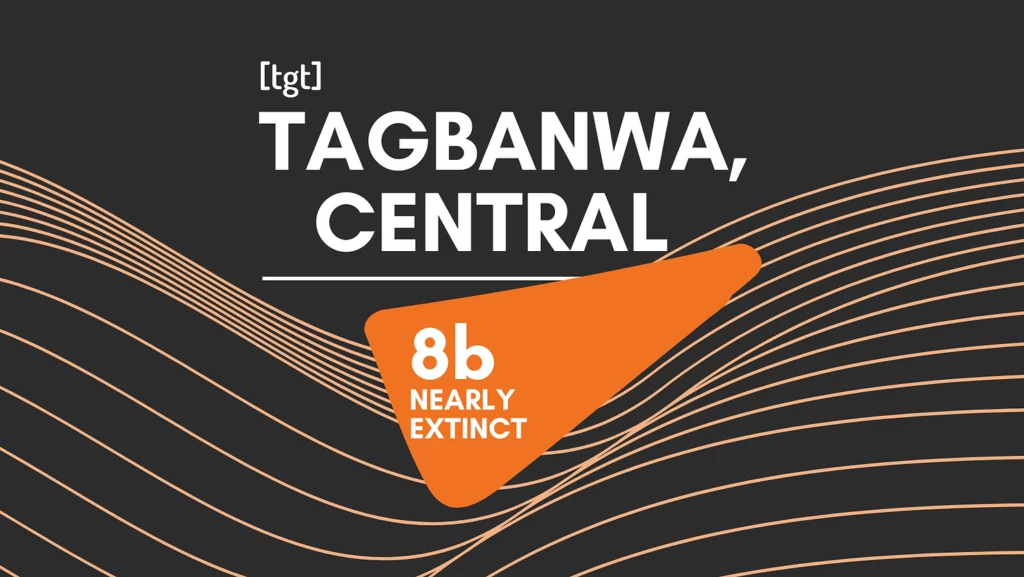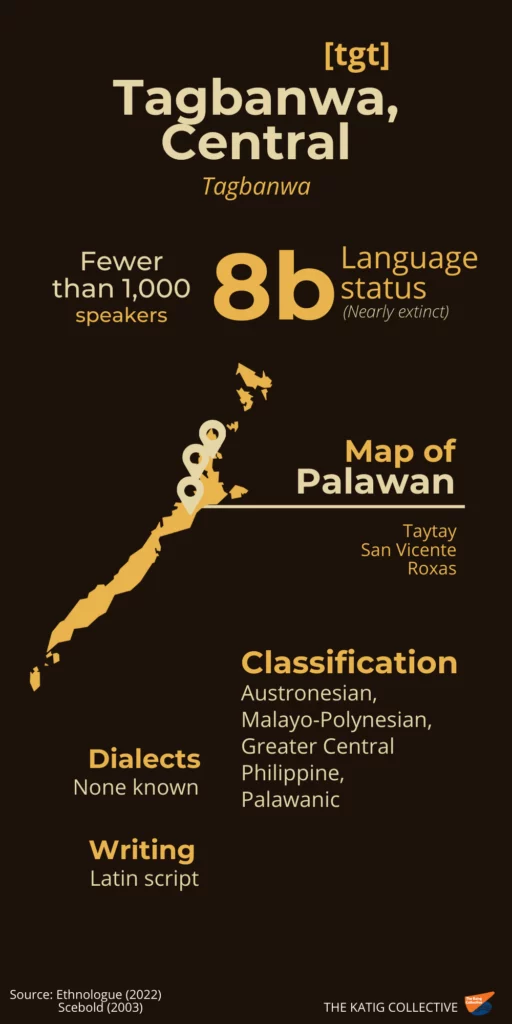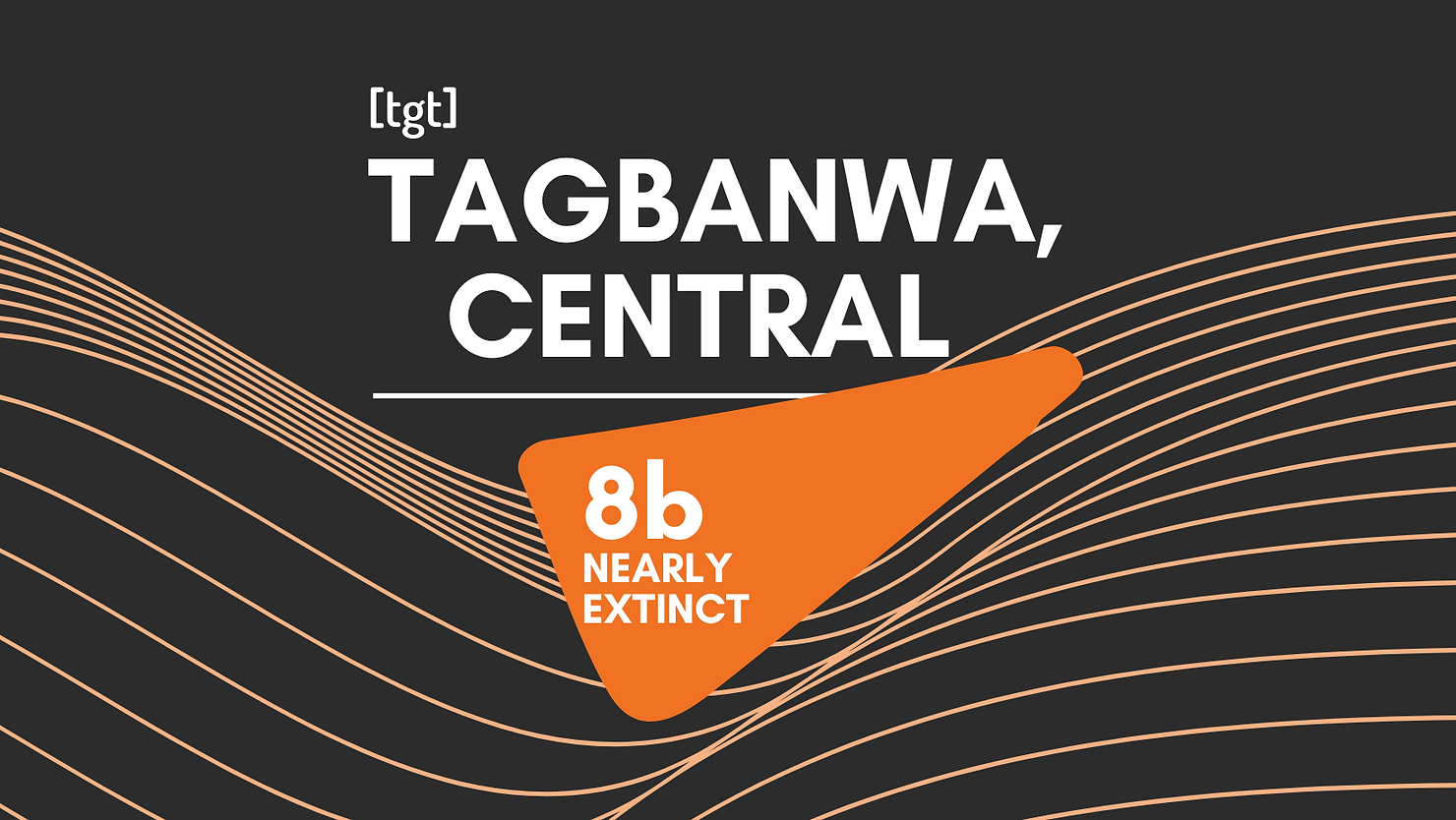Tagbanwa, Central
Tagbanwa, Central [tgt] is one of the three Tagbanwa languages spoken in Palawan. Its users are found in the northwestern part of the province, particularly in the municipalities of Taytay, Roxas, and San Vicente (Scebold, 2003). The language is considered nearly extinct (EGIDS 8b) in Ethnologue, with a reported user population of 2,000 in 1985. The number has dwindled since then (Eberhard et al., 2022).
The Tagbanwa people
The Tagbanwa are among the oldest groups in the Philippines. The Central Tagbanwa people are the original inhabitants of northern Palawan where they lived in a stable environment until World War II (Scebold, 2003). They also have their religion with four main gods and perform rituals for the deities (Joshua Project, n.d.). By the time Scebold conducted his research in the early 1990s, their total population was estimated to be between 800 and 1,000.

On the causes of endangerment
Several factors contributed to the decline of the Central Tagbanwa language. The people were forced to go into hiding when Japanese forces terrorized the area during the war, and most of them died from malnutrition or disease. The in-migration of Agutaynen [agn], Cuyunon [cyo], and Tagalog [tag] speakers in hopes of seeking land and livelihood opportunities after the war also affected the Central Tagbanwa population (Olofson, 2007). Interethnic marriages resulted in ethnically and linguistically diverse children who gradually shifted to speaking languages used in wider communication such as English [eng], Tagalog, and Cuyunon (Scebold, 2003). These, coupled with the operation of dominant institutions such as education, government, and media, influenced the community’s language and cultural shift.

Works about Tagbanwa, Central
Literature about Central Tagbanwa is scarce. Scebold (2003) published a book containing a description of the language’s phonology, grammar, and lexicon in an attempt to “chronicle the language shift that is taking place” and to “document the language before it dies completely” (p. ix). Wordlists compiled by Nickell (1979) and Green (1981) are also available in the SIL International online archives.
References
Eberhard, D. M., Simons, G. F., & Fennig, C. D. (Eds.). (2022). Tagbanwa, Central. Ethnologue: Languages of the World (25th ed.). https://www.ethnologue.com/language/tgt
Endangered Languages Project. (n.d.). Central Tagbanwa. https://www.endangeredlanguages.com/lang/5087
Green, P. (Comp.). (1981). Tagbanwa – Maulid wordlist. SIL International. https://www.sil.org/resources/archives/80086
Hammarström, H., Forkel, R., Haspelmath, M., & Bank, S. (Eds.). (2022). Spoken L1 language: Central Tagbanwa. Glottolog 4.6. https://glottolog.org/resource/languoid/id/cent2090
Joshua Project. (n.d.). Central Tagbanwa in Philippines. https://joshuaproject.net/people_groups/11139/RP
Nickell, T. L. (Comp.). (1979). Binganin (Komdong) wordlist. SIL International. https://www.sil.org/resources/archives/79687
Olofson, H. (2007). [Review of the book Central Tagbanwa: A Philippine language on the brink of extinction, by R. A. Scebold]. Philippine Quarterly of Culture and Society, 35(4), 400-402. https://www.jstor.org/stable/29792634
Open Language Archives Community. (n.d.). OLAC resources in and about the Central Tagbanwa language. http://www.language-archives.org/language/tgt
Scebold, R. A. (2003). Central Tagbanwa: A Philippine language on the brink of extinction. Linguistic Society of the Philippines special monograph issue 48. https://www.sil.org/resources/archives/25537

